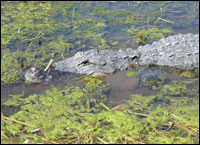Dear Umbra,
I recently visited Moab, Utah, and found that many people there use “swamp coolers” rather than conventional air-conditioning systems. Moab is in a near-desert environment and has frequent water-shortage problems. I’m wondering whether this swamp-cooler method of air-conditioning is really greener than the systems most of the rest of us use, and whether it is depleting the already low water supply in these Southwestern desert areas. How does it stack up cost-wise against other types of cooling systems? My AC broke down this spring, and if I am able to get enough money together by next summer, I’d like to install a new system and have it be as environmentally friendly as possible.
Marilyn
Libertyville, Ill.
Dearest Marilyn,

Does this swamp need cooling?
How can you not love something called a swamp cooler? You should certainly investigate these moisture-based cooling systems.
Swamp coolers use a fan to pull hot exterior air over a moist membrane and into your house. The hot air absorbs the cooler water and itself cools on its way inside. A window in the house must be open so that air can circulate. Swamp coolers use far less electricity than air conditioners (an environmental and economic benefit), they circulate air from the outside rather than repeatedly running the same air through the system (a health benefit), and they add moisture to a dry house (a furniture benefit). They typically use between three and 10 gallons of water per day. That’s equivalent to two toilet flushes, on one end, or a short shower, on the other.
I think swamp coolers are a good option. Air-conditioning is a huge burden on the summer electricity grid, and while electricity sources vary, few of them are environmentally amiable. If you have very limited water resources in your area, you should run the idea of getting a swamp cooler past your water utility or a local environmental group that addresses water issues in your area.
The trouble for you, Marilyn, is that even if you get the environmental go-ahead, the Land of Lincoln may be too humid for a swamp cooler to be effective. These coolers work best in dry climates. In humid areas they just make air more humid. Check out this chart defining the useful range of swamp coolers. If it seems like it might work for your area, call a dealer or your local hippie home store to delve deeper.
Should the swamp cooler be a no-go, there are other potentially effective steps you can take before sinking resources — yours and Mother Earth’s — into an air conditioner. During Keeping-Cool Theme Question Fortnight, we will drill these into readers’ minds. Close your house down during the heat of the day. Install awnings over the hottest windows, and consider planting some shade-producing trees as well. Insulate your attic; it turns out that the attic is a heat sponge and creating barriers between it and the living space beneath can make a big difference. You can easily install insulation in the floor of the attic or paper/aluminum “radiant barrier” sheeting on the inside of the roof. Both of these are economical barrier techniques that will help reduce the heat inside your home (if the attic is also ventilated). The instructions for radiant barrier sheeting look fairly simple, and may involve the use of a staple gun. Fun!
Next week I will discuss a very efficient option that you should also investigate: the whole-house fan. I’m not just forcing you to keep reading: I’m out of room.
Radiantly,
Umbra


